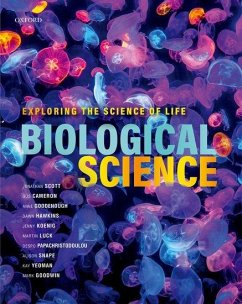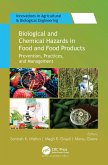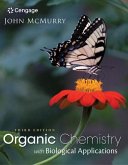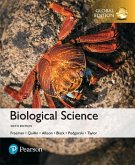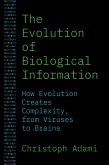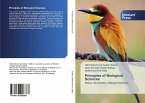Jon Scott (Emeritus Pro Emeritus Professor of Bioscience Education, Gus Cameron (School of Bioc Reader in Biomedical Science Education, Anne Goodenough (Professor in Applied Professor in Applied Ecology
Biological Science
Exploring the Science of Life
Jon Scott (Emeritus Pro Emeritus Professor of Bioscience Education, Gus Cameron (School of Bioc Reader in Biomedical Science Education, Anne Goodenough (Professor in Applied Professor in Applied Ecology
Biological Science
Exploring the Science of Life
- Broschiertes Buch
- Merkliste
- Auf die Merkliste
- Bewerten Bewerten
- Teilen
- Produkt teilen
- Produkterinnerung
- Produkterinnerung
A fresh approach to biology centred on a clear narrative, active learning, and confidence with quantitative concepts and scientific enquiry. Spanning the breadth of biological science and designed for flexible learning, it will give you a deeper understanding of the key concepts, and an appreciation of biology as a dynamic experimental science.
Andere Kunden interessierten sich auch für
![Biological Science Biological Science]() Jon Scott (Emeritus Pro Emeritus Professor of Bioscience EducationBiological Science68,99 €
Jon Scott (Emeritus Pro Emeritus Professor of Bioscience EducationBiological Science68,99 €![Biological Motion Biological Motion]() Janina WellmannBiological Motion29,99 €
Janina WellmannBiological Motion29,99 €![Biological and Chemical Hazards in Food and Food Products Biological and Chemical Hazards in Food and Food Products]() Biological and Chemical Hazards in Food and Food Products193,99 €
Biological and Chemical Hazards in Food and Food Products193,99 €![Organic Chemistry with Biological Applications Organic Chemistry with Biological Applications]() John McMurry (Cornell University)Organic Chemistry with Biological Applications449,99 €
John McMurry (Cornell University)Organic Chemistry with Biological Applications449,99 €![Biological Science, Global Edition Biological Science, Global Edition]() Scott FreemanBiological Science, Global Edition113,99 €
Scott FreemanBiological Science, Global Edition113,99 €![The Evolution of Biological Information The Evolution of Biological Information]() Christoph AdamiThe Evolution of Biological Information141,99 €
Christoph AdamiThe Evolution of Biological Information141,99 €![Principles of Biological Sciences Principles of Biological Sciences]() Hafiz Muhammad Zeshan SafdarPrinciples of Biological Sciences56,99 €
Hafiz Muhammad Zeshan SafdarPrinciples of Biological Sciences56,99 €-
-
-
A fresh approach to biology centred on a clear narrative, active learning, and confidence with quantitative concepts and scientific enquiry. Spanning the breadth of biological science and designed for flexible learning, it will give you a deeper understanding of the key concepts, and an appreciation of biology as a dynamic experimental science.
Hinweis: Dieser Artikel kann nur an eine deutsche Lieferadresse ausgeliefert werden.
Hinweis: Dieser Artikel kann nur an eine deutsche Lieferadresse ausgeliefert werden.
Produktdetails
- Produktdetails
- Verlag: Oxford University Press
- Seitenzahl: 1416
- Erscheinungstermin: 29. Juli 2022
- Englisch
- Abmessung: 275mm x 216mm x 50mm
- Gewicht: 3026g
- ISBN-13: 9780198783688
- ISBN-10: 019878368X
- Artikelnr.: 62432866
- Herstellerkennzeichnung
- Libri GmbH
- Europaallee 1
- 36244 Bad Hersfeld
- gpsr@libri.de
- Verlag: Oxford University Press
- Seitenzahl: 1416
- Erscheinungstermin: 29. Juli 2022
- Englisch
- Abmessung: 275mm x 216mm x 50mm
- Gewicht: 3026g
- ISBN-13: 9780198783688
- ISBN-10: 019878368X
- Artikelnr.: 62432866
- Herstellerkennzeichnung
- Libri GmbH
- Europaallee 1
- 36244 Bad Hersfeld
- gpsr@libri.de
Jon Scott, Emeritus Professor of Bioscience Education, University of Leicester, Gus Cameron, Reader in Biomedical Science Education, School of Biochemistry, University of Bristol, Anne Goodenough, Professor in Applied Ecology, University of Gloucestershire, Dawn Hawkins, Reader, Faculty of Science and Engineering, Anglia Ruskin University, Jenny Koenig, Assistant Professor in Pharmacology, Therapeutics and Toxicology, Faculty of Medicine & Health Sciences, University of Nottingham, Martin Luck, Emeritus Professor of Physiological Education, University of Nottingham, Despo Papachristodoulou, Reader of Medical Education, King's College London, Alison Snape, Reader in Bioscience Education, King's College London, Kay Yeoman, Professor of Science Communication, School of Biological Sciences, University of East Anglia, Mark Goodwin, Associate Professor in the Department of Genetics and Genome Biology, University of Leicester
Life and its Exploration: Foundational Principles
Topic 1: Exploring the science of life
Topic 2: The emergence of life on Earth
Topic 3: Defining Life
Topic 4: Evolutionary processes
Topic 5: The diversity, organisation, and classification of life
Quantitative Toolkits
Quantitative Toolkit 1: Understanding data
Quantitative Toolkit 2: Size and scale
Quantitative Toolkit 3: Describing data
Quantitative Toolkit 4: Ratio and proportion
Quantitative Toolkit 5: Understanding samples
Quantitative Toolkit 6: Designing experiments
Quantitative Toolkit 7: Assessing patterns
Quantitative Toolkit 8: Formulae and equations
Quantitative Toolkit 9: Rates of change
Module 1 LIFE AT THE MOLECULAR LEVEL
1: Building blocks: molecules and macromolecules
2: Energy: powering biochemical processes
3: Information: genes and genomes
4: Mendelian genetics
5: Reading the genome: gene expression and protein synthesis
6: Proteins and proteomes
7: Metabolism: energy capture and release from food
8: Molecular tools and techniques
Module 2 LIFE AT THE CELLULAR LEVEL
9: Characteristics of prokaryotic and eukaryotic cells
10: Cell division in prokaryotes and eukaryotes
11: Microbial diversity
12: The growth, measurement, and visualisation of cells
13: Microbes in life: harnessing their power
14: Microbes as agents of infectious disease
15: Viruses
Module 3 THE HUMAN ORGANISM: TISSUES, ORGANS, AND SYSTEMS
16: Physiology overview
17: Communication and control 1: introducing the nervous and endocrine systems
18: Communication and control 2: sensory systems
19: Communication and control 3: controlling organ systems
20: Muscle and movement
21: Cardiovascular system
22: Respiratory system
23: Exercise physiology
24: Renal system
25: Digestive system
26: Reproductive system
27: Immune system
Module 4 ORGANISMAL DIVERSITY: STRUCTURE, ADAPTATION, AND SURVIVAL
28: The structure of living organisms
29: Body plans
30: Interaction with the external environment
31: Movement, locomotion, and migration
32: Defence against predation and invasion
33: Reproduction and development
Module 5 ORGANISMS IN THEIR ENVIRONMENTS
34: Fundamental concepts: ecology, evolution, species, and speciation
35: Genes: evolutionary change in alleles, genotypes, and phenotypes
36: Populations: quantifying demographics and modelling change
37: Communities: species interactions and biodiversity metrics
38: Ecosystems: abiotic interactions and environmental processes
39: Challenges: key threats to ecosystems
40: Solutions: managing, conserving, and restoring ecosystems
Topic 1: Exploring the science of life
Topic 2: The emergence of life on Earth
Topic 3: Defining Life
Topic 4: Evolutionary processes
Topic 5: The diversity, organisation, and classification of life
Quantitative Toolkits
Quantitative Toolkit 1: Understanding data
Quantitative Toolkit 2: Size and scale
Quantitative Toolkit 3: Describing data
Quantitative Toolkit 4: Ratio and proportion
Quantitative Toolkit 5: Understanding samples
Quantitative Toolkit 6: Designing experiments
Quantitative Toolkit 7: Assessing patterns
Quantitative Toolkit 8: Formulae and equations
Quantitative Toolkit 9: Rates of change
Module 1 LIFE AT THE MOLECULAR LEVEL
1: Building blocks: molecules and macromolecules
2: Energy: powering biochemical processes
3: Information: genes and genomes
4: Mendelian genetics
5: Reading the genome: gene expression and protein synthesis
6: Proteins and proteomes
7: Metabolism: energy capture and release from food
8: Molecular tools and techniques
Module 2 LIFE AT THE CELLULAR LEVEL
9: Characteristics of prokaryotic and eukaryotic cells
10: Cell division in prokaryotes and eukaryotes
11: Microbial diversity
12: The growth, measurement, and visualisation of cells
13: Microbes in life: harnessing their power
14: Microbes as agents of infectious disease
15: Viruses
Module 3 THE HUMAN ORGANISM: TISSUES, ORGANS, AND SYSTEMS
16: Physiology overview
17: Communication and control 1: introducing the nervous and endocrine systems
18: Communication and control 2: sensory systems
19: Communication and control 3: controlling organ systems
20: Muscle and movement
21: Cardiovascular system
22: Respiratory system
23: Exercise physiology
24: Renal system
25: Digestive system
26: Reproductive system
27: Immune system
Module 4 ORGANISMAL DIVERSITY: STRUCTURE, ADAPTATION, AND SURVIVAL
28: The structure of living organisms
29: Body plans
30: Interaction with the external environment
31: Movement, locomotion, and migration
32: Defence against predation and invasion
33: Reproduction and development
Module 5 ORGANISMS IN THEIR ENVIRONMENTS
34: Fundamental concepts: ecology, evolution, species, and speciation
35: Genes: evolutionary change in alleles, genotypes, and phenotypes
36: Populations: quantifying demographics and modelling change
37: Communities: species interactions and biodiversity metrics
38: Ecosystems: abiotic interactions and environmental processes
39: Challenges: key threats to ecosystems
40: Solutions: managing, conserving, and restoring ecosystems
Life and its Exploration: Foundational Principles
Topic 1: Exploring the science of life
Topic 2: The emergence of life on Earth
Topic 3: Defining Life
Topic 4: Evolutionary processes
Topic 5: The diversity, organisation, and classification of life
Quantitative Toolkits
Quantitative Toolkit 1: Understanding data
Quantitative Toolkit 2: Size and scale
Quantitative Toolkit 3: Describing data
Quantitative Toolkit 4: Ratio and proportion
Quantitative Toolkit 5: Understanding samples
Quantitative Toolkit 6: Designing experiments
Quantitative Toolkit 7: Assessing patterns
Quantitative Toolkit 8: Formulae and equations
Quantitative Toolkit 9: Rates of change
Module 1 LIFE AT THE MOLECULAR LEVEL
1: Building blocks: molecules and macromolecules
2: Energy: powering biochemical processes
3: Information: genes and genomes
4: Mendelian genetics
5: Reading the genome: gene expression and protein synthesis
6: Proteins and proteomes
7: Metabolism: energy capture and release from food
8: Molecular tools and techniques
Module 2 LIFE AT THE CELLULAR LEVEL
9: Characteristics of prokaryotic and eukaryotic cells
10: Cell division in prokaryotes and eukaryotes
11: Microbial diversity
12: The growth, measurement, and visualisation of cells
13: Microbes in life: harnessing their power
14: Microbes as agents of infectious disease
15: Viruses
Module 3 THE HUMAN ORGANISM: TISSUES, ORGANS, AND SYSTEMS
16: Physiology overview
17: Communication and control 1: introducing the nervous and endocrine systems
18: Communication and control 2: sensory systems
19: Communication and control 3: controlling organ systems
20: Muscle and movement
21: Cardiovascular system
22: Respiratory system
23: Exercise physiology
24: Renal system
25: Digestive system
26: Reproductive system
27: Immune system
Module 4 ORGANISMAL DIVERSITY: STRUCTURE, ADAPTATION, AND SURVIVAL
28: The structure of living organisms
29: Body plans
30: Interaction with the external environment
31: Movement, locomotion, and migration
32: Defence against predation and invasion
33: Reproduction and development
Module 5 ORGANISMS IN THEIR ENVIRONMENTS
34: Fundamental concepts: ecology, evolution, species, and speciation
35: Genes: evolutionary change in alleles, genotypes, and phenotypes
36: Populations: quantifying demographics and modelling change
37: Communities: species interactions and biodiversity metrics
38: Ecosystems: abiotic interactions and environmental processes
39: Challenges: key threats to ecosystems
40: Solutions: managing, conserving, and restoring ecosystems
Topic 1: Exploring the science of life
Topic 2: The emergence of life on Earth
Topic 3: Defining Life
Topic 4: Evolutionary processes
Topic 5: The diversity, organisation, and classification of life
Quantitative Toolkits
Quantitative Toolkit 1: Understanding data
Quantitative Toolkit 2: Size and scale
Quantitative Toolkit 3: Describing data
Quantitative Toolkit 4: Ratio and proportion
Quantitative Toolkit 5: Understanding samples
Quantitative Toolkit 6: Designing experiments
Quantitative Toolkit 7: Assessing patterns
Quantitative Toolkit 8: Formulae and equations
Quantitative Toolkit 9: Rates of change
Module 1 LIFE AT THE MOLECULAR LEVEL
1: Building blocks: molecules and macromolecules
2: Energy: powering biochemical processes
3: Information: genes and genomes
4: Mendelian genetics
5: Reading the genome: gene expression and protein synthesis
6: Proteins and proteomes
7: Metabolism: energy capture and release from food
8: Molecular tools and techniques
Module 2 LIFE AT THE CELLULAR LEVEL
9: Characteristics of prokaryotic and eukaryotic cells
10: Cell division in prokaryotes and eukaryotes
11: Microbial diversity
12: The growth, measurement, and visualisation of cells
13: Microbes in life: harnessing their power
14: Microbes as agents of infectious disease
15: Viruses
Module 3 THE HUMAN ORGANISM: TISSUES, ORGANS, AND SYSTEMS
16: Physiology overview
17: Communication and control 1: introducing the nervous and endocrine systems
18: Communication and control 2: sensory systems
19: Communication and control 3: controlling organ systems
20: Muscle and movement
21: Cardiovascular system
22: Respiratory system
23: Exercise physiology
24: Renal system
25: Digestive system
26: Reproductive system
27: Immune system
Module 4 ORGANISMAL DIVERSITY: STRUCTURE, ADAPTATION, AND SURVIVAL
28: The structure of living organisms
29: Body plans
30: Interaction with the external environment
31: Movement, locomotion, and migration
32: Defence against predation and invasion
33: Reproduction and development
Module 5 ORGANISMS IN THEIR ENVIRONMENTS
34: Fundamental concepts: ecology, evolution, species, and speciation
35: Genes: evolutionary change in alleles, genotypes, and phenotypes
36: Populations: quantifying demographics and modelling change
37: Communities: species interactions and biodiversity metrics
38: Ecosystems: abiotic interactions and environmental processes
39: Challenges: key threats to ecosystems
40: Solutions: managing, conserving, and restoring ecosystems

